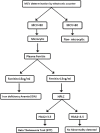Comparing prevalence of Iron Deficiency Anemia and Beta Thalassemia Trait in microcytic and non-microcytic blood donors: suggested algorithm for donor screening
- PMID: 20808655
- PMCID: PMC2920481
- DOI: 10.4103/0973-6247.53883
Comparing prevalence of Iron Deficiency Anemia and Beta Thalassemia Trait in microcytic and non-microcytic blood donors: suggested algorithm for donor screening
Abstract
Background: The prevalence of microcytosis in donors and Iron Deficiency Anemia (IDA) and Beta-Thalassemia trait (BTT) in microcytic and non-microcytic donors has not been studied in India. The present study aims at finding the same.
Materials and methods: Initially 925 donor samples were evaluated on cell-counter. Of these, 50 were found to be microcytic. These were subjected to Ferritin and HbA2 determination. Subsequently, an additional 51, age-and-sex matched non-microcytic donor samples were selected to serve as controls. These were subjected to the same tests.
Results: The prevalence of microcytosis was 5.4% (50/925). Among the microcytic donors, 52% were IDA, 36% BTT, 8% both, and 4% none. In case of non-microcytic donors 29.4% were IDA, 3.9% BTT, and 66.7% none.
Conclusions: The study revealed a high prevalence of IDA and BTT in blood donors and a higher probability of finding these in the microcytic samples. This prompted authors to suggest an algorithm for screening of blood donors for IDA and BTT. The algorithm recommends doing an hemogram on all donor samples, routinely. Ferritin could be done only in microcytic samples. At levels lower than15 ng/ml, it is diagnosed as IDA, and therefore, HPLC is performed only for non-IDA samples with Ferritin levels higher than 15 ng/ml. By employing this algorithm, a substantial number of IDA and BTT could be diagnosed while keeping the number of Ferritin tests small and the number of HPLC tests even smaller and thus making it cost efficient.
Keywords: Algorithm; Beta-Thalassemia trait; Ethylenediaminetetraacetic acid; Hemoglobin (Hb); High Performance Liquid Chromatography; Iron Deficiency Anemia; Plasma Ferritin.
Conflict of interest statement
Figures
Similar articles
-
Utility of screening tools to differentiate beta thalassemia trait and iron-deficiency anemia - do they serve a purpose in blood donors?Blood Res. 2020 Sep 30;55(3):169-174. doi: 10.5045/br.2020.2020219. Blood Res. 2020. PMID: 32989178 Free PMC article.
-
Approach to blood donors with microcytosis.Transfus Med. 2010 Apr;20(2):88-94. doi: 10.1111/j.1365-3148.2009.00980.x. Epub 2009 Dec 7. Transfus Med. 2010. PMID: 20003131
-
Distinguishing Iron Deficiency Anemia From Beta-Thalassemia Trait: Comparative Analysis of CRUISE Index and Other Traditional Diagnostic Indices.Cureus. 2024 Jul 7;16(7):e64048. doi: 10.7759/cureus.64048. eCollection 2024 Jul. Cureus. 2024. PMID: 39114184 Free PMC article.
-
Application of Innovative Hemocytometric Parameters and Algorithms for Improvement of Microcytic Anemia Discrimination.Hematol Rep. 2015 Jun 23;7(2):5843. doi: 10.4081/hr.2015.5843. eCollection 2015 Jun 3. Hematol Rep. 2015. PMID: 26331001 Free PMC article. Review.
-
Anemia and hematinic deficiencies in oral mucosal disease patients with microcytosis.J Formos Med Assoc. 2017 Jul;116(7):505-511. doi: 10.1016/j.jfma.2017.02.005. Epub 2017 Mar 11. J Formos Med Assoc. 2017. PMID: 28291568 Review.
Cited by
-
A search for Beta thalassemia trait in India.Turk J Haematol. 2012 Dec;29(4):427-9. doi: 10.5505/tjh.2012.21703. Epub 2012 Dec 5. Turk J Haematol. 2012. PMID: 24385736 Free PMC article. No abstract available.
-
Thalassemia and hemoglobin e in southern thai blood donors.Adv Hematol. 2014;2014:932306. doi: 10.1155/2014/932306. Epub 2014 Jun 23. Adv Hematol. 2014. PMID: 25050123 Free PMC article.
-
Utility of screening tools to differentiate beta thalassemia trait and iron-deficiency anemia - do they serve a purpose in blood donors?Blood Res. 2020 Sep 30;55(3):169-174. doi: 10.5045/br.2020.2020219. Blood Res. 2020. PMID: 32989178 Free PMC article.
-
Evaluation of Platelet and Red Blood Cell Parameters with Proposal of Modified Score as Discriminating Guide for Iron Deficiency Anemia and β-Thalassemia Minor.J Clin Diagn Res. 2016 May;10(5):EC31-4. doi: 10.7860/JCDR/2016/17672.7843. Epub 2016 May 1. J Clin Diagn Res. 2016. PMID: 27437228 Free PMC article.
References
-
- Oski FA. Iron deficiency in infancy and childhood. N Engl J Med. 1993;329:190–3. - PubMed
-
- Wharton BA. Iron deficiency in children: Detection and prevention. Br J Haematol. 1999;106:270–80. - PubMed
-
- Olivieri NF. The beta-thalassemias. N Engl J Med. 1999;341:99–109. - PubMed
-
- Lukens JN. The thalassemias and related disorder: An overview. In: Lee GR, et al., editors. Wintrobe’s Clinical Hematology. 10th ed. Giza: Mass Publishing; 1999. pp. 405–33.
-
- Wonke B, Modell M, Marlow T, Khan M, Modell B. Microcytosis, iron deficiency and thalassemia in a multi-ethnic community: A pilot study. Scand J Clin Lab Invest. 2007;67:87–96. - PubMed


